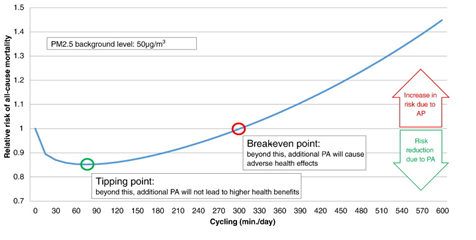The health benefits of cycling outweigh the safety risks by a factor of 20 to one. Source.
Cyclists on average live two years longer than non-cyclists and take 15% fewer days off work through illness. Source.
An adult who cycles regularly will typically have a level of fitness equivalent to being 10 years younger.
Source:Tuxworth, B. 1986, Quality control. Sport and Leisure, 1986 Vol. 27 No. 3 pp. 32-33
Countries with the highest levels of cycling and walking generally have the lowest obesity rates. Source.
Cycling has a positive effect on emotional health – improving levels of well-being, self-confidence and tolerance to stress while reducing tiredness, difficulties with sleep and a range of medical symptoms.
Source: Boyd, H., Hillman, M., Nevill, A., Pearce, A. and Tuxworth, B. (1998). Health-related effects of regular cycling on a sample of previous non-exercisers, Resume of main findings.
People cycling to work ‘mortality rate is 28% below the average population. Source.
Walking and cycling have benefits at the population level. As has been the case for decades, the biggest impact at the public health level would come from increasing the levels of walking and cycling by those population groups who do the least walking and cycling. Source.
Ekelund ea 2015, reporting on the EPIC study, looked at all-cause mortality and all types of physical activity and came to the same conclusion: even small increases in activity in inactive individuals would benefit public health.
Source: Ulf Ekelund, Heather A Ward, Teresa Norat, Jian’an Luan, Anne M May, Elisabete Weiderpass, Stephen S Sharp, ea… Physical activity and all-cause mortality across levels of overall and abdominal adiposity in European men and women: the European Prospective Investigation into Cancer and Nutrition Study (EPIC). Am J Clin Nutr First published ahead of print January 14, 2015 as doi: 10.3945/ajcn.114.100065.
In 2011 Rojac-Rueda et al examined the health risks and benefits of cycling in urban environments compared with car use and specifically looked at Bicing Barcelona’s bicycle sharing scheme. They found that the health benefits of physical activity were large compared with risks from air pollutants and road traffic incidents.
Source: Rojac-Rueda, D et al „The health risks and benefits of cycling in urban environments compared with car use: health impact assessment study“ BMJ 2011; 343: d4521 doi: 10.1136/bmj.d452
T ainio ea 2016 asked the question that so many wonder about: Can air pollution negate the health benefits of cycling and walking? They answered it with a resounding “no” unless you’re cycling more than 5 hours in some of the world’s worst polluted cities. They also noted that there are higher health benefits than risks due to pollution for the first hour of cycling per day (see in the picture on the left). Source.
ainio ea 2016 asked the question that so many wonder about: Can air pollution negate the health benefits of cycling and walking? They answered it with a resounding “no” unless you’re cycling more than 5 hours in some of the world’s worst polluted cities. They also noted that there are higher health benefits than risks due to pollution for the first hour of cycling per day (see in the picture on the left). Source.
Flint ea 2014 investigation found that more active transport, including walking and cycling and using public transport to work independently predicts lower BMI and a healthier body composition in both adult women and men.
Source: Flint ea 2014 Associations between active commuting, body fat, and body mass index: population based, cross sectional study in the United Kingdom BMJ 2014;349:g4887 doi: 10.1136/bmj.g4887 (Published 19 August 2014).
Mytton ea 2016 investigated the longitudinal associations of active commuting with BMI and found that those who maintained cycle commuting to work over 1 year self-reported a lower BMI than those adults who never cycled to work. The effect was stronger for people who were overweight. Source.
Suminski ea 2014 created a model to explain the relationship between bicycle policies in the 48 largest US cities and overweight/obesity. They found fewer overweight and obese residents in the large cities that have more cycle promotion policies. This is in part due to the relationship between such policies and the infrastructure needed to support commuter cycling.
Source: Suminski ea 2014 “Bicycling policy indirectly associated with overweight/obesity.” American J Preventive Medicine.
De Geus and Hendriksen concluded that most users have health benefits because the nature of the pedelec which requires the user to keep pedalling to have the motorizwed assist. They suggested that it’s especially good for those just starting to cycle, and for the elderly. Source.
Recent Publications on Physical Activity and Health you can find here.
Contact Us
Avenue des Arts, 7-8
Postal address: Rue de la Charité, 22
1210 Brussels, Belgium
